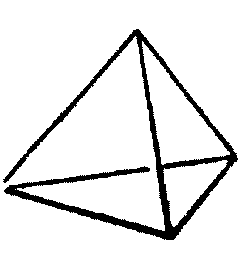BACKGROUND:
 Geometric shapes help describe minerals. A platonic
solid is composed of a single repeated polygon. The five platonic solids are
the tetrahedron (4 triangles), cube (6 squares), icosahedron (20 triangles),
octahedron (8
triangles) and dodecahedron (12 pentagons). The Archimedean solids are
composed of combinations of polygons and named after the Greek philosopher
Archimedes.
Geometric shapes help describe minerals. A platonic
solid is composed of a single repeated polygon. The five platonic solids are
the tetrahedron (4 triangles), cube (6 squares), icosahedron (20 triangles),
octahedron (8
triangles) and dodecahedron (12 pentagons). The Archimedean solids are
composed of combinations of polygons and named after the Greek philosopher
Archimedes.
The Greek philosopher Plato, who was born around 430
B.C., wrote about these five solids in a work called Timaeus. Historical
accounts vary a little, but it is usually agreed that the solids themselves
were discovered by the early Pythagoreans, perhaps by 450 B.C.
There is evidence that the Egyptians knew about at
least three of the solids; their work influenced the Pythagoreans. In any
case, Plato mentioned these solids in his writings He identified them with
the elements then commonly believed to make up all matter in the universe;
fire, air, water, earth, and the cosmos (the universe itself). Plato
identified fire atoms with the tetrahedron, earth atoms with the cube, air
atoms with the octahedron, water atoms with the icosahedron, and the cosmos
atoms with the dodecahedron.
PROCEDURE:
- Have the students make their own geometric forms using Googolplex. Use
the workbooks to direct their work. You may wish to have the students
work in groups.
- You may want the students to determine the geometries of the mineral
specimens that they used in the lab. The following key lists the
geometric shapes of the lab specimens, along those of some other common
minerals .
QUARTZ, AMETHYST, CITRINE (prism with six sides)
CALCITE, FELDSPAR, GYPSUM (3d parallelogram or rhombohedron)
HALITE, PYRITE, GALENA, (cube)
GARNET (dodecahedron (12 sides))
DIAMOND (hexatetrahedron or dipyramid (8 sides))
FLUORITE (isohedron)